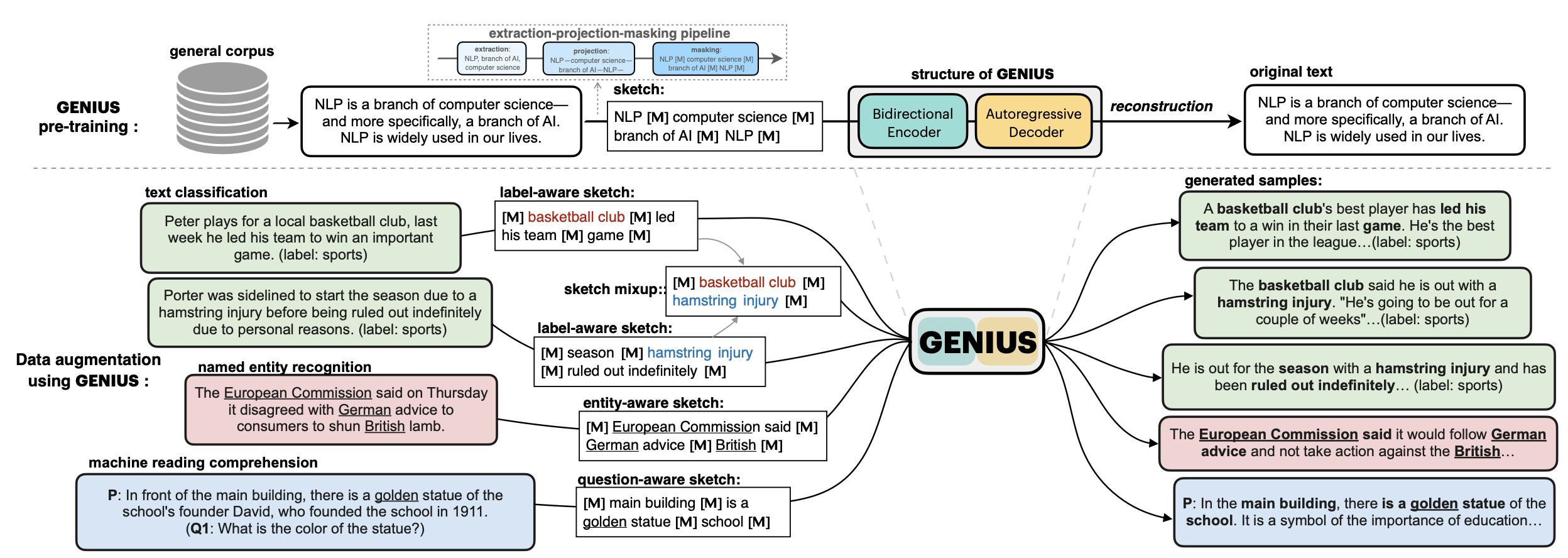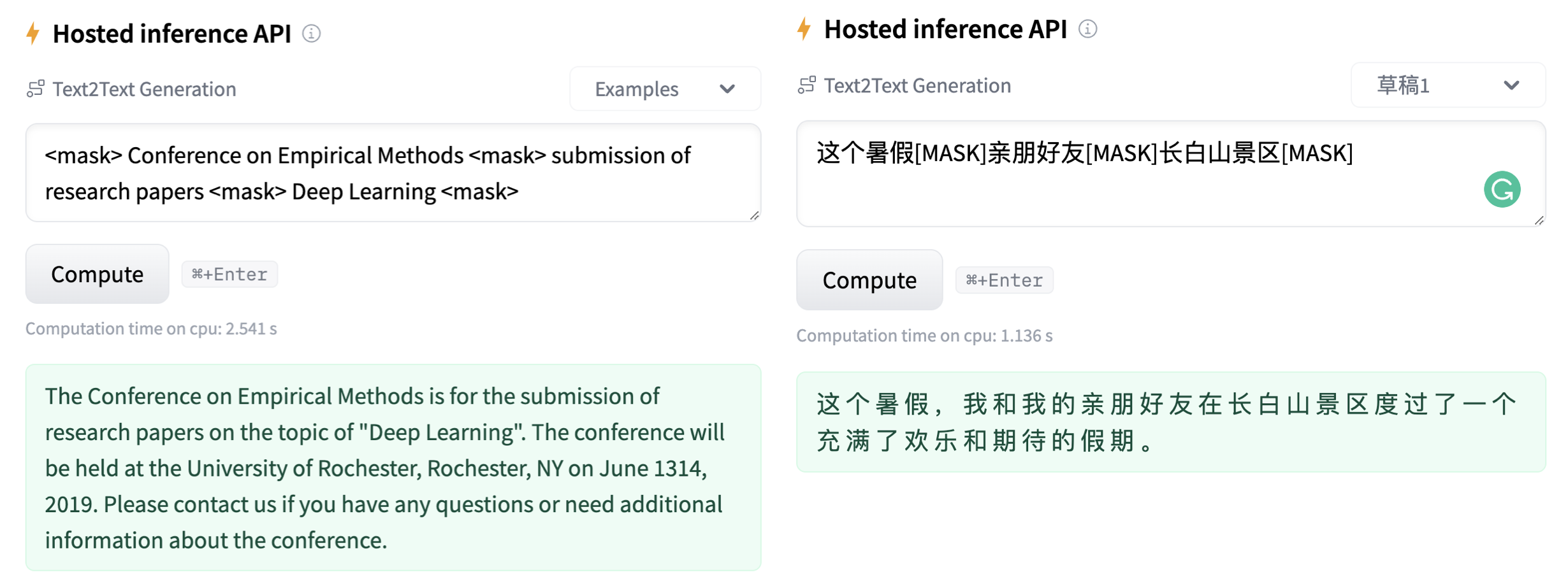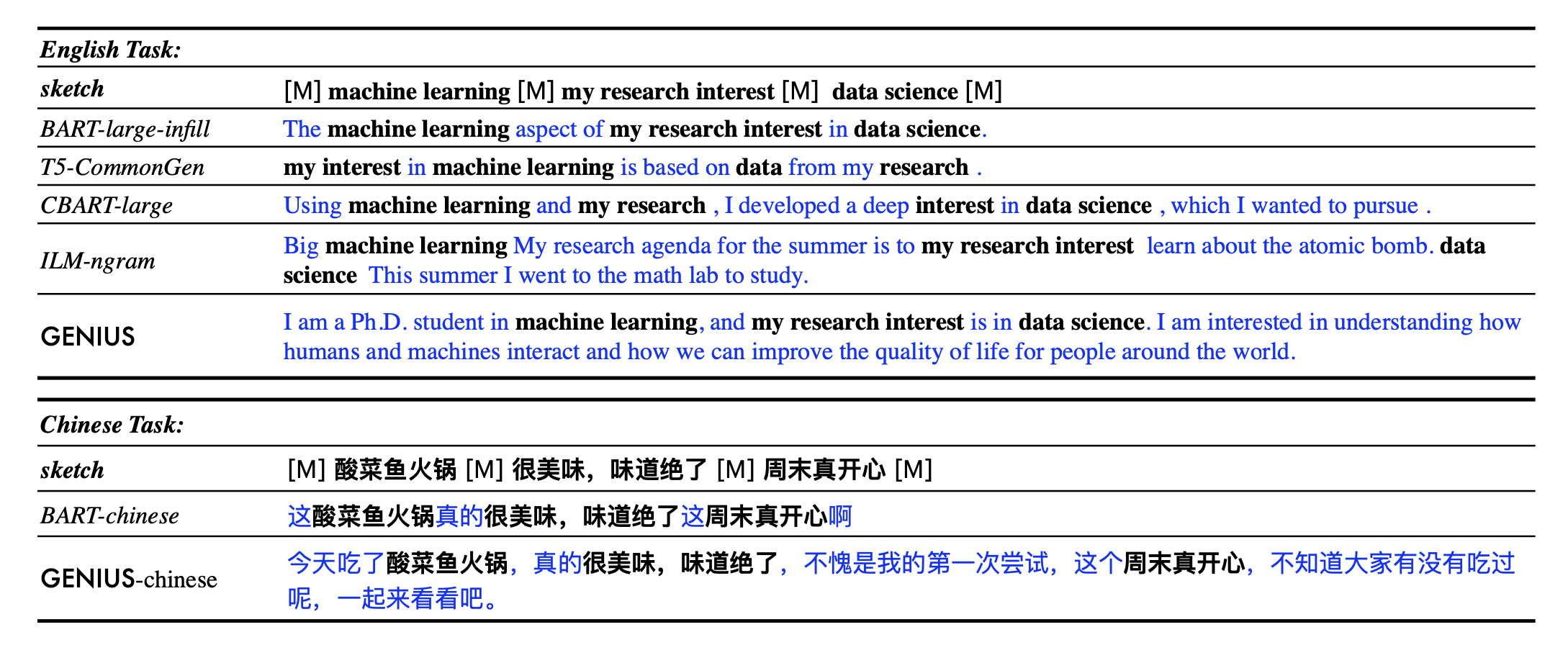💡GENIUS – generating text using sketches!
基于草稿的文本生成模型
💡GENIUS is a powerful conditional text generation model using sketches as input, which can fill in the missing contexts for a given sketch (key information consisting of textual spans, phrases, or words, concatenated by mask tokens). GENIUS is pre-trained on a large- scale textual corpus with a novel reconstruction from sketch objective using an extreme and selective masking strategy, enabling it to generate diverse and high-quality texts given sketches.
Example 1:
- sketch:
__ machine learning __ my research interest __ data science __ - GENIUS:
I am a Ph.D. student in machine learning, and my research interest is in data science. I am interested in understanding how humans and machines interact and how we can improve the quality of life for people around the world.
Example 2:
- sketch:
自然语言处理__谷歌__通用人工智能__ - GENIUS:
自然语言处理是谷歌在通用人工智能领域的一个重要研究方向,其目的是为了促进人类智能的发展。
GENIUS can also be used as a general textual data augmentation tool for various NLP tasks (including sentiment analysis, topic classification, NER, and QA).
- Models hosted in 🤗 Huggingface:
Model variations:
| Model | #params | Language | comment |
|---|---|---|---|
genius-large |
406M | English | The version used in paper (recommend) |
genius-large-k2t |
406M | English | keywords-to-text |
genius-base |
139M | English | smaller version |
genius-base-ps |
139M | English | pre-trained both in paragraphs and short sentences |
genius-base-chinese |
116M | 中文 | 在一千万纯净中文段落上预训练 |
More Examples:
Usage
What is a sketch?
First, what is a sketch? As defined in our paper, a sketch is "key information consisting of textual spans, phrases, or words, concatenated by mask tokens". It's like a draft or framework when you begin to write an article. With GENIUS model, you can input some key elements you want to mention in your wrinting, then the GENIUS model can generate cohrent text based on your sketch.
The sketch which can be composed of:
- keywords /key-phrases, like
__NLP__AI__computer__science__ - spans, like
Conference on Empirical Methods__submission of research papers__ - sentences, like
I really like machine learning__I work at Google since last year__ - or a mixup!
How to use the model
1. If you already have a sketch in mind, and want to get a paragraph based on it...
from transformers import pipeline
# 1. load the model with the huggingface `pipeline`
genius = pipeline("text2text-generation", model='beyond/genius-large', device=0)
# 2. provide a sketch (joint by <mask> tokens)
sketch = "<mask> Conference on Empirical Methods <mask> submission of research papers <mask> Deep Learning <mask>"
# 3. here we go!
generated_text = genius(sketch, num_beams=3, do_sample=True, max_length=200)[0]['generated_text']
print(generated_text)Output:
'The Conference on Empirical Methods welcomes the submission of research papers. Abstracts should be in the form of a paper or presentation. Please submit abstracts to the following email address: eemml.stanford.edu. The conference will be held at Stanford University on April 1618, 2019. The theme of the conference is Deep Learning.'If you have a lot of sketches, you can batch-up your sketches to a Huggingface Dataset object, which can be much faster.
TODO: we are also building a python package for more convenient use of GENIUS, which will be released in few weeks.
2. If you have an NLP dataset (e.g. classification) and want to do data augmentation to enlarge your dataset...
Please check genius/augmentation_clf and genius/augmentation_ner_qa, where we provide ready-to-run scripts for data augmentation for text classification/NER/MRC tasks.
Augmentation Experiments:
Data augmentation is an important application for natural language generation (NLG) models, which is also a valuable evaluation of whether the generated text can be used in real applications.
- Setting: Low-resource setting, where only n={50,100,200,500,1000} labeled samples are available for training. The below results are the average of all training sizes.
- Text Classification Datasets: HuffPost, BBC, SST2, IMDB, Yahoo, 20NG.
- Base classifier: DistilBERT
In-distribution (ID) evaluations:
| Method | Huff | BBC | Yahoo | 20NG | IMDB | SST2 | avg. |
|---|---|---|---|---|---|---|---|
| none | 79.17 | 96.16 | 45.77 | 46.67 | 77.87 | 76.67 | 70.39 |
| EDA | 79.20 | 95.11 | 45.10 | 46.15 | 77.88 | 75.52 | 69.83 |
| BackT | 80.48 | 95.28 | 46.10 | 46.61 | 78.35 | 76.96 | 70.63 |
| MLM | 80.04 | 96.07 | 45.35 | 46.53 | 75.73 | 76.61 | 70.06 |
| C-MLM | 80.60 | 96.13 | 45.40 | 46.36 | 77.31 | 76.91 | 70.45 |
| LAMBADA | 81.46 | 93.74 | 50.49 | 47.72 | 78.22 | 78.31 | 71.66 |
| STA | 80.74 | 95.64 | 46.96 | 47.27 | 77.88 | 77.80 | 71.05 |
| GeniusAug | 81.43 | 95.74 | 49.60 | 50.38 | 80.16 | 78.82 | 72.68 |
| GeniusAug-f | 81.82 | 95.99 | 50.42 | 50.81 | 79.40 | 80.57 | 73.17 |
Out-of-distribution (OOD) evaluations:
| Huff->BBC | BBC->Huff | IMDB->SST2 | SST2->IMDB | avg. | |
|---|---|---|---|---|---|
| none | 62.32 | 62.00 | 74.37 | 73.11 | 67.95 |
| EDA | 67.48 | 58.92 | 75.83 | 69.42 | 67.91 |
| BackT | 67.75 | 63.10 | 75.91 | 72.19 | 69.74 |
| MLM | 66.80 | 65.39 | 73.66 | 73.06 | 69.73 |
| C-MLM | 64.94 | 67.80 | 74.98 | 71.78 | 69.87 |
| LAMBADA | 68.57 | 52.79 | 75.24 | 76.04 | 68.16 |
| STA | 69.31 | 64.82 | 74.72 | 73.62 | 70.61 |
| GeniusAug | 74.87 | 66.85 | 76.02 | 74.76 | 73.13 |
| GeniusAug-f | 76.18 | 66.89 | 77.45 | 80.36 | 75.22 |
BibTeX entry and citation info
If you find our paper/code/demo useful, please cite our paper:
@article{guo2022genius,
title={GENIUS: Sketch-based Language Model Pre-training via Extreme and Selective Masking for Text Generation and Augmentation},
author={Guo, Biyang and Gong, Yeyun and Shen, Yelong and Han, Songqiao and Huang, Hailiang and Duan, Nan and Chen, Weizhu},
journal={arXiv preprint arXiv:2211.10330},
year={2022}
}



